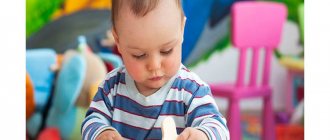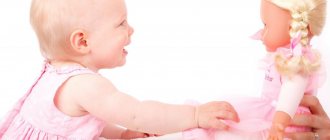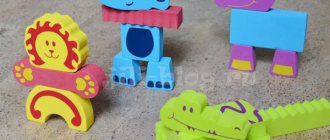Summary of an open lesson on FEMP in the first junior group “Geometric Figures”
The teacher suggests tracing a circle with your finger.
Educator: Let's look further:
- I have three tops, three corners, three sides. Who am I?
Children: Triangle.
He takes out a triangle and attaches it next to the circle: “What else did the Bunny bring us? What is the name of this figure?
The teacher invites the children to repeat the name of the figure in chorus, and for some children to show its sides and angles.
Educator: Well done! And here is another figure:
“I’m not an oval, I’m not a circle, I’m not a friend to a triangle,
This is the kind of brother I am.
And my name is...
Children: Square.
Then he takes out a square, places it next to the triangle, names the figure, shows the sides and corners of the square and asks the children: “What does a square have? How many sides does a square have? How many angles does a square have?
The teacher asks the children to circle the square and show its sides (corners).
The teacher summarizes the children's answers and actions.
part 2
. Educator: “What great fellows you all are. They correctly named all the geometric shapes that Bunny brought. I think he really enjoyed being with you, and he offers to warm up a little.
Physical school
The little gray bunny sits and wiggles his ears!
(Children squat down and use their hands to imitate how a bunny moves its ears)
Just like that, like that, and he moves his ears!
It's cold for the bunny to sit, we need to warm his little paws,
That's it, that's it, we need to warm our little paws!
(Children lightly clap palm to palm, then stand up)
It's cold for the bunny to stand, the bunny needs to jump!
Hop - hop - hop - hop, the bunny needs to jump!
(Children jump on two legs, pressing their hands to their chest)
Someone scared the bunny, the bunny jumped and ran away.
(The children scatter in all directions, and the teacher takes the fox and runs after the bunnies)
Educator: - Well done! The bunny told me that in our group there are a lot of objects that have the same shape as his gifts - a circle, a square, a triangle. And he offers to find them.
Look, under each of you there is a card with a picture of a circle, square, triangle. Take them and look at them. Then look carefully at our group and find something round, square, triangular.
(Children, in accordance with the image on the card, find the necessary objects of round, square, triangular shape.)
Educator: Well done, you also coped with this task.
Part 3.
Outdoor game "Find your house."
There is a circle, a triangle and a square on the tables. Children take one geometric figure that was under their chairs and call them the keys to the house (hoop). Children with keys go to the carpet and begin to move to the music. At the end of the melody, the teacher says that it is night and they must find their houses: those with a circle in their hands run to the circle, those with a triangle run to the triangle, those with a square run to the square. When the children take their places, the teacher asks them to justify their choice.
Mathematics lesson in 1st junior group. Circle and square
Summary of a lesson on the formation of elementary mathematical concepts in the 1st junior group.
Topic: Geometric figures: circle and square Purpose: to consolidate ideas about geometric figures - circle and square. Objectives: Educational:
- teach to recognize, distinguish and find geometric shapes: circle and square;
- learn to correlate a geometric figure with its model; - teach children to navigate in space, use prepositions -under, -for, -7na Developmental:
- develop attention;
- develop the ability to analyze and work with didactic material Educational:
- cultivate interest in joint activities with peers;
- develop a sense of community; - cultivate a sense of empathy for the characters Speech:
- development of coherent speech - teach children to answer the question “how much?”
the word "a lot"; - use of words in speech: circle, square, round shape, square shape. Preliminary work: • Reading fiction “Zayushkina’s Hut” • D/i “Geometric Figures” • Games “Fox and Hares” • Finger gymnastics “House” Developing subject-spatial environment: Dienesh blocks (circles and squares of different sizes and colors), 2 houses, pictures with square and round objects, toys: a fox and a hare, a circle and a square made of cardboard.
Progress:
Chairs on the carpet in a semicircle.
Educator: Children, sit down on the chairs. The back was straightened, the arms were placed on the knees. There's a knock on the door. Educator: Guys, who is that knocking? I'll go open the door. (I take the hare and fox toys) That's who knocked on our door! Did you find out? Children: Yes, it's the fox and the hare. Educator: Where do you think they came to us from? Children: from the forest. Educator: Do you remember the fairy tale about the fox and the hare? Children: Yes, Zayushka’s hut. The fox kicked the bunny out of the house because her hut had melted. Educator: Correct. But now the fox and the hare have become friends, the fox promised not to offend the bunny anymore. Today they came to visit us so that the children could help them build houses. Let's help the animals? Children: Yes! Educator: Let's get down to work together and build new houses for the fox and the hare. And let them “walk” around our group. Finger gymnastics All day long knock and knock - a ringing sound is heard (hands clenched into fists, thumb raised up, tapping on the index finger) Hammers knock (knock fist on fist) We build a house for the animals. This is such a good house. How wonderful we will live! (show “roof”) Educator: These are the kind of houses we got! Where are our little animals? Let's go look for them. Are they near the closet? Children: No Teacher: Is there something under the table? Children: No! Jr. At this time, the teacher scatters Dienesh blocks in the form of a path on the floor. Educator: That's where they are! They hid behind the sofa! Dana, where are the little animals hiding? Children: Behind the sofa. (I ask 3-4 children) Educator: Fox, bunny, we built houses for you, let’s go have a look. Oh, there's a blockage on our way. How will we get to the house?! To go further, we need to clear the road. Guys, these are not ordinary stones. Look what shape they are? What geometric shapes do they resemble? Children: circle and square. Educator: Well done! Let's clear the path of stones. We will put all the round pebbles on the round “stump”, and square-shaped pebbles on the square “stump”. What shape of pebble did you take? Why did you put it here? (2-3 children) Good guys, everyone did it! Because we worked together, because together it turns out faster and better: everyone managed to arrange the pebbles into shape. Look! These are houses. But they are different. What is painted on this house? Children: circle Teacher: And in the other house? Children: square Educator: How can we now understand who gets which house? Look, the animals have badges. What shape is the fox's badge? Children: square Teacher: What about the bunny? Children: round Teacher: Well done! Now we know where whose house is. Let's plant them next to our houses. Bunny, your house is round. What should we say to the fox? “Fox, your house is square.” Let's visit each other together. And you, kids, sit down on the chairs. Guys, there is nothing in the houses of the fox and the hare. How to be? We need to help them arrange their huts. Are you ready to help? Children: Yes Educator: I have pictures, but they are not simple. Some objects on them are round, and some are square. What do you think we should put in the fox’s house? What shape? Children: square Teacher: What shape of objects should we put in the house for the bunny? Children: Round. Educator: Why? Children: Because the bunny has a round icon. I suggest going to the table and taking 1 picture. Ask the children: “What is shown in the picture? What shape? Who needs to be put in the house?” Educator: Well done. You were able to determine the shape of objects in the pictures. The animals became cheerful and happy! Because their house is no longer empty, it has many items that they need every day. They thank you for their new homes, for being able to furnish them, and invite you to play with them and celebrate their housewarming. Outdoor game “Fox and Hares”
We leave the animals in the houses, say goodbye to them
Teacher, Children: Goodbye, fox and bunny! All the best to you!
We recommend watching:
Summary of GCD in the 1st junior group on FEMP “Let's treat the Bunny with a carrot” Summary of GCD in the 1st junior group on the formation of a holistic picture of the world Summary of a design lesson in the 1st junior group Summary of a lesson with children of the first junior group
Similar articles:
Summary of GCD in the 1st junior group by February 23
Lesson notes for the early childhood group in kindergarten
Lesson summary for an early age group. Cockerel
Lesson summary for an early age group. Dandelion
Summary of a game development lesson in kindergarten in the second group of early age on the topic: Toys
Notes on mathematics in 1st junior group
Summary of the final lesson in the first junior group on cognitive development (FEMP) on the topic: “Funny little train”
Program content:
Consolidate knowledge of the number of objects (one-many); primary colors (red, blue, green, yellow); learn to assemble a whole from parts; ability to distinguish the size of objects (large - small). Develop fine motor skills of children's hands. Develop memory, thinking, intelligence. To foster friendly relationships between children and interest in activities.
Material:
a toy bear, chairs for children, carriages, wheels, two boxes (large and small), toys large and small.
Progress of the lesson
Educator:
Guys, we have guests today. Let's say hello to them.
Children:
Hello!
Educator:
Look who it is?
(children answer “A steam locomotive and carriages.”
Tell me how many locomotives and carriages?
( there is one locomotive, but there are many carriages).
Correct!
1. Didactic game
“One - many”
Purpose:
consolidate the ability to distinguish between the number of objects (one-many), when answering, use the words one, many.
Educator:
But you and I can’t go because our trailers don’t have wheels. Let us repair them for you.
2. Didactic game
“match by color”
Game progress:
invite the children to help the trailers find their own color. On one table there are trailers and wheels. The child needs to take one trailer, find the trailer by color (the same as the trailer), and name the color. The game continues until all the trailers have wheels.
Educator:
Well done boys.
Educator:
Now take your seats and let’s go visit the bear. Here we are. Look, the bear is sitting and crying. Let's go and ask the bear what happened.
Educator
: Children, Mishka told me in my ear that he was playing with the toys, but now he can’t put them back into the box. So that his mother does not scold him, let us help him and collect all the toys.
3. Didactic game
“Cut pictures”
Objectives: to teach how to assemble a whole from parts; develop children's thinking; To form in children ideas about the holistic image of an object, to teach them to correlate the image of the idea with the holistic image of a real object, to fold a picture cut into 4 parts. Act by applying. To cultivate in children attention, perseverance, and perseverance in completing the assigned task.
Equipment. Cut pictures from 4 parts. Items and toys that match those in the pictures.
4 .
Didactic game “more - less”
Purpose:
strengthen the ability to distinguish objects by size.
Equipment:
two boxes (large and small), toys (large and small), a toy bear.
Progress of the game.
Children need to help the bear put the toys into the box. Collect large toys in a large box, and small ones in a small one.
Educator:
Fine! Guys, the bear thanks you for your help. Look, I still have a box, the bear has prepared a sweet treat for you. It's time for us to go back to kindergarten. We take our seats and set off. - Attention attention! Next stop: Kindergarten.
Educator:
So we returned to the Kindergarten.
Tell me who we met during our journey ( children's answers
). Did you like it?
Summary of educational activities for FEMP in the early age group “Houses for a bear”
Summary of GCD for FEMP
in the early age group "Houses for a Bear"
Objectives: 1.Teach the ability to compare objects by size
visual correlation method;
2. Sort objects of two different sizes;
3. Learn to distinguish between the number of objects: “one - many” and “big - small”
4. Learn to answer the question “how much?”
5.Development of the ability to follow certain rules when solving problems;
6. Development of thinking and attention;
7. cultivate interest in the activity; make you want to do simple tasks.
Materials used: bear toy, large and small cubes, large and small cars.
Progress of the lesson
Educator: Guys, a guest has come to us! But to find out
Who is this, we need to guess a riddle about him.
Listen here:
The furry beast loves honey. If he doesn’t understand something, he may roar wildly, because he is... (a bear)
Children: Bear!
Educator: That's right, guys, it's a bear. .
Look, there he is. But he didn’t come to visit us empty-handed, he was carrying something in the car. What is this bear in the car?
Children: Cubes!!!
Educator: That's right, these are cubes. But why does the bear need so many cubes? Shall we ask him?
Bear: I wanted to build a house out of cubes for my cubs: for big cubs - from large cubes,
for little bear cubs - from small cubes, but suddenly the fox cubs came running and mixed all the cubes, and now I just can’t figure it out. What should I do now...
Educator: Don’t be sad, bear, we will help you!!!
Really, guys?
Children: Yes!!!
Educator: We will sort out the cubes, bring your truck here quickly.
Educator: Look, guys, I have a big house on this table, and a small one on this table. What kind of cubes do you think are suitable for a large house?
Children: Big cubes.
Educator: That's right. What cubes are suitable for a small house?
Children: Little ones.
Educator: Correct. Then let's divide the cubes into two piles.
(Children are asked to arrange the cubes by size)
Educator: Well, bear, how did the guys help you?
Bear: Thanks, guys!
Educator: Guys, our little bear is feeling cold, let’s show him how to quickly warm up.
Physical education minute:
Stomp, bear
Clap, bear
Squat with me, brother,
Hands up, forward and down.
Smile and sit down.
Educator: Guys, our bear needs to return home. But how can he take the cubes home? They might get mixed up again. What do we do?
(Children's guesses)
Educator: Look, I have another car. What is she like? Big or small? (The teacher places the previous car next to it so that the children can visually compare them)




